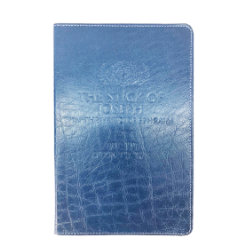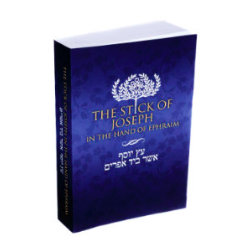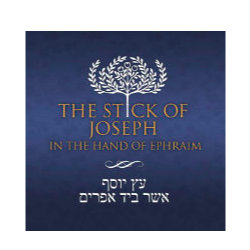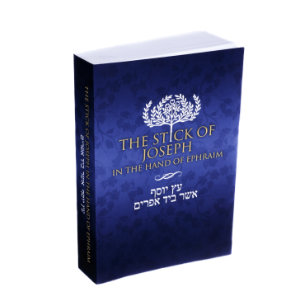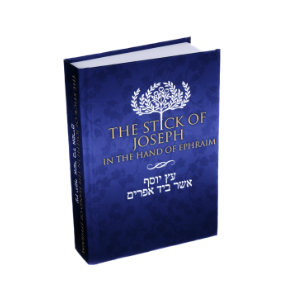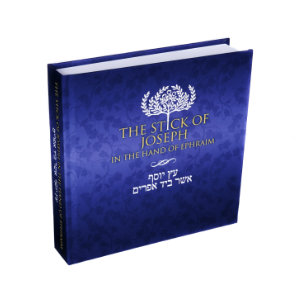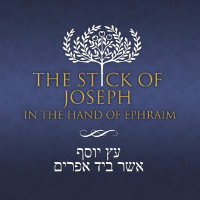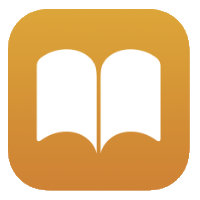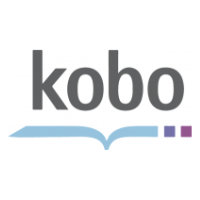The Most Sublime and Direct Israelite Ascension Text in Existence
The Stick of Joseph in the Hand of Ephraim is a sacred, first-temple-period, Israelite text, written by a prophetic family from the tribe of Joseph, who fled Jerusalem in 601 BCE, prior to the Babylonian destruction. YHWH led them for years in the wilderness and finally brought them “over the wall” to the ancient American continent, in fulfillment of Jacob’s final blessing to Joseph (Genesis 49:22).
For a thousand years, these ancient Israelites built their civilization, fought wars, served the God of Israel, and kept this holy record for their future descendants. When their civilization ended in destruction (420 CE), their final prophet, M’roni, hid this record in the ground, to come forth in our day and begin the restoration of scattered Israel to its former glory.
This is their message to their future posterity, preserved for thousands of years, and prepared by God for you, today. Will you hear it?
Introduction
The ancient House of Israel consisted of twelve families, or tribes, named for the twelve sons of Jacob (Israel). Ten of those tribes were conquered, driven from their homelands, and scattered throughout the world. Although their bloodlines continue, they have lost their identity with the House of Israel. The remaining two tribes have retained their identity, and are now known as the Jewish people, named for the tribe of Judah.
Over two thousand five hundred years ago, the prophet Ezekiel foretold a future day when the spirit of YHWH would stir the scattered remnants of Israel and restore them to life (Ezek. 37:11–14). He also prophesied of a second scriptural record that would come forth from the tribe of Joseph to Judah, in the hand of Joseph’s son, Ephraim. This record would be used by YHWH to gather all of scattered Israel home to their lands, into one people and one family that He would again call His own (Ezek. 37:15–23; see also Appendix E).
This is that prophesied record.
This is the only Hebrew Messianic/ascension document in existence that has not been influenced by entanglements with Babylon, Greece, or Rome, because those who kept the record left Jerusalem and the Eastern Hemisphere prior to the Babylonian captivity. It is the most sublime and direct Jewish ascension text in existence.
Initial Discovery and Publication of the Text
In 1820 CE, the God of Israel called a prophet to begin the long-prophesied work of restoration. When He appeared to that prophet, Yosef ben Yosef (Joseph Smith, Jr.), He declared the corruption of all Christian religions and His intent to restore His covenant people. On Rosh Hashanah 5588 (1827 CE), Yosef received this ancient record from an angel at the place where it had been buried for over 1400 years. Yosef received divine power and means to translate the ancient text and publish it to the world.
Yosef ben Yosef first published the text for a Gentile audience, in antiquated English, under a different title. As happened with the Bible, Gentile churches and institutions attempted to claim the book as their own, make profit from it, and use it to gain converts—all while utterly failing to appreciate its authors, purpose, message, or destiny (see 2 Nefi 12:8). For more information about the first published text, see the Appendices at the back of the book.
Although the text itself acknowledges it will convince some few Gentiles to believe in Israel’s God, the text’s main focus is directed to the scattered remnants of the House of Israel, with the stated purpose of restoring the knowledge of YHWH’s covenants and gathering YHWH’s people, in preparation for the time of Mashiach.
Current Translation
Nearly 190 years after the first English translation of the text, YHWH set His hand again the second time to gather His people (Isaiah 11:11) and called servants to prepare and publish the text in its current form, without the encumbrance of Gentile language and concepts. Part of this effort involved removing antiquated English words and expressions, as well as restoring Hebraic terms that would have been used by the original writers. This Hebraic-roots English translation reveals the ancient Hebraic nature of this record and provides a clear understanding of Israel’s God, His work now underway, and the coming age of Mashiach.
The original, intended title of the work has also been restored, as stated by Yosef ben Yosef, who called it The Stick of Joseph in the Hand of Ephraim on multiple, recorded occasions. (see Letter to Stephen Post, 17 September 1838, p. 2; Joseph Smith History, Part 19 (April–May 1830) paragraph 7.)
Numerous footnotes have been added to explain Hebraic concepts, reference language and ideas also found in the Tanakh, and provide deeper understanding and explanations. Many footnotes also provide cross references to other areas of the text to enhance the reader’s understanding. However, the reader should know that the footnotes are not part of the original text and should not be regarded as anything more than the opinions of those preparing this current version for publication. Likewise, because the text is so thoroughly Hebraic in nature, the number of footnotes regarding Hebraisms has been intentionally limited to a few representative cases. A thorough treatment of the Hebraic nature of the text would fill multiple volumes.
Many ideas presented in this ancient work persisted in Jewish thought for thousands of years and appeared again in later Jewish sources. Such sources have been referenced when applicable; see Abbreviations and References in Appendix A for further information. Text found within The Stick of Joseph that also appears in the Tanakh is featured in bold.
A Glossary is provided at the end of the volume, with explanations of Hebraic names and terms.
YHWH, who keeps His covenants, has now decreed the restoration of His people Israel, by sending The Stick of Joseph to Judah in the hand of Ephraim. The glory of this accomplishment belongs to YHWH alone. This is His work and His text, though it came through the hands of imperfect mortals. If there are errors, they are the fault of those who have labored to recover this text.
Purpose and Intent of this Translation
This effort is a direct response to the promise of YHWH that He would restore the House of Israel. Because true worship always requires sacrifice, thousands of dollars and thousands of hours have been freely given to this project on a volunteer basis, without compensation. Those who have contributed their time and means have done so to offer a gift to the world, with no intent other than to obey YHWH and see His covenants fulfilled. Therefore, this book is sold at publisher’s cost, with the specific intent of eliminating any profit. The text is also available at no cost.
First published in this form at Rosh Hashanah 5780 (2019 CE), The Stick of Joseph is YHWH’s call to all the House of Israel. He has not forgotten His people, and He invites all to return to Him, remember His covenants with their fathers, obey His commandments, and prepare for the glorious day of Mashiach.
Within this sacred text, YHWH issues a specific warning against those who would attempt to profit financially, elevate themselves above others, or attempt to gain control over others in any way by using this book or its teachings:
He commands that there shall be no priestcrafts; for behold, priestcrafts are that men preach and set themselves up for a light unto the world, that they may get gain and praise of the world, but they seek not the welfare of Tziyon…But the laborer in Tziyon shall labor for Tziyon, for if they labor for money, they shall perish. (2 Nefi 11:17)
This record was originally published separately from any church, assembly, or organization. Therefore, accepting The Stick of Joseph does not require one to be institutionally loyal to any organization, group, or man. It was written unto all nations (see Dedication in Appendix F). Those who believe these words are invited to repent, obey the Mitzvot of YHWH, and be immersed as a sign of acceptance.
The House of Israel, the Jewish People, and The Stick of Joseph
Three major world religions claim Abraham as patriarch. Jews and Christians also acknowledge Abraham’s son, Isaac, and grandson, Jacob, as Abraham’s successors in YHWH’s covenant. Jacob was renamed Israel and given twelve sons who became the “twelve tribes” or “house” of Israel. The texts of every Abrahamic religion record the story of the second youngest son, Joseph, who was sold into Egyptian slavery by his brothers and who subsequently saved Israel’s entire family from a decimating famine.
The family of Israel eventually became scattered throughout the world. Most lost their identity and connection to Israel, with the exception of the tribe of Judah, for whom the Jews are named. The tribe of Judah’s tenacity and sacrifice over thousands of years preserved sacred texts, traditions, and teachings going all the way back to the patriarchs. Although the Jews are but one of the twelve tribes, their very name has become synonymous with Israel.
The remaining “lost” tribes do not know their identity, though they carry the blood of Abraham, Isaac, and Jacob. Prophecy foretells their future return to the family, and lands, of Israel. Malachi prophesied that Elijah would come to turn the hearts of the children back to their fathers (Mal. 3:23–24 [4:5–6]). This text is sent in the spirit of Elijah, as part of that mission. Its purpose is to turn the hearts of all the family of Israel, not only to the covenants of Abraham, Isaac, and Jacob, but also to Mashiach, who will come.
Both supporters and detractors of the modern state of Israel recognize its founding and growth as a phenomenon without parallel in world history. This book boldly predicts a future for Israel beyond what any without the spirit of prophecy could foretell. Those scattered remnants who yet carry the blood of Israel will resonate in a singular way with its message.
Isaiah holds special significance in this text and is quoted extensively by the first prophet-writer, Nefi. This is due to Isaiah’s singular position as a seer who saw and prophesied of our present day. You are encouraged to consider the Isaiah materials in light of the explanations given within this text.
Other first-temple-period prophets are also referenced or quoted by the writers of The Stick of Joseph. Likewise the Torah is quoted, with comments and explanations by the ancient prophet-writers of this work.
A Note of Warning About this Book
The Stick of Joseph in the Hand of Ephraim is not just another book. Rather it is all of the following unique and extraordinary things:
- The sounding of the shofar to the scattered tribes of Israel as YHWH’s final attempt to gather His people;
- A dire warning to the United States of America and a cry of repentance to the modern state of Israel. Any nation that does not honor the Elohim of Israel will not survive;
- An independent witness of the prophets, Mashiach, and the covenants given by YHWH to Israel;
- A record of the means whereby all mankind can, as Moses, ascend to stand in the presence of YHWH;
- An invitation to believe and receive the promises that YHWH extends to those who will be His people.
As is always the case with Elohim’s work, there will be opposition to this effort. Those who fight against it or say, “This is just…” or “That is not…” in an attempt to re-cast this text as something other than what it says it is are dangerously ignorant, wicked, or both. They do not know or honor the God of Abraham who vouches for these words; in fact, they fight against Him. They are trifling with your soul, and if you pay them heed, you will receive only disappointment.
A Promise to the Reader
The only way to know the truth of this record is to examine it for yourself. You are invited to study the contents of The Stick of Joseph and to experiment upon M’roni’s petition, found in the final chapter:
Behold, I would exhort you that when you shall read these things, if it be wisdom in Elohim that you should read them, that you would remember how merciful YHWH has been unto the children of men, from the creation of Adam even down until the time that you shall receive these things, and ponder it in your hearts. And when you shall receive these things, I would exhort you that you would ask Elohim the Eternal Father, in the name of Mashiach, if these things are not true. And if you shall ask with a sincere heart, with real intent, having faith in Mashiach, and he will manifest the truth of it unto you by the power of the Ruach HaKodesh. And by the power of the Ruach HaKodesh, you may know the truth of all things. (M’roni 10:2)
Elohim, who cannot lie, will keep His word.
Read Now
Scroll down for physical books, digital books, pdf, and online versions.
Leather-bound, Heirloom Quality Books
These are the highest-quality versions of the book available with the following features:
- 100% cotton, acid-free paper
- Top-quality, sewn leather covers
- Gold-leaf edge gilding
- Sturdy hand-stitched bindings
- Choice of color and leather as listed
Print on Demand
The Stick of Joseph in the Hand of Ephraim is available for print-on-demand ordering. This means that when you place your order, your book will be printed in the format you choose and shipped to you. Typical printing time is 1-3 days, and shipping time varies by location.
The book is also available through various retailers at various price points. The links below place the order directly with the publisher and provide the lowest price available. We have set the price at the lowest point the publisher will allow, in an effort to eliminate any profit coming from this book.
Digital Book Options
The following electronic formats provide free versions of the book. All links provide immediate access or download.
In addition, the live text link provides access to a searchable, web-based version of the book online.
E-book Book Options
The following electronic formats provide low cost versions of the book for the most common eBook platforms. All links provide immediate access and download.
